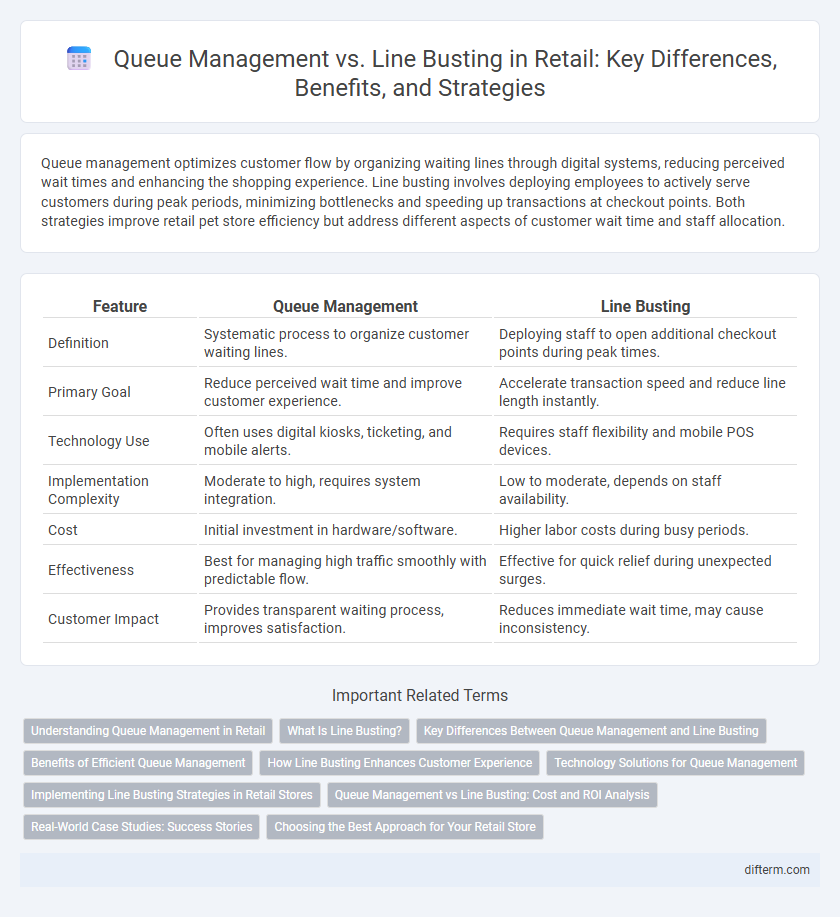Queue management optimizes customer flow by organizing waiting lines through digital systems, reducing perceived wait times and enhancing the shopping experience. Line busting involves deploying employees to actively serve customers during peak periods, minimizing bottlenecks and speeding up transactions at checkout points. Both strategies improve retail pet store efficiency but address different aspects of customer wait time and staff allocation.
Table of Comparison
| Feature | Queue Management | Line Busting |
|---|---|---|
| Definition | Systematic process to organize customer waiting lines. | Deploying staff to open additional checkout points during peak times. |
| Primary Goal | Reduce perceived wait time and improve customer experience. | Accelerate transaction speed and reduce line length instantly. |
| Technology Use | Often uses digital kiosks, ticketing, and mobile alerts. | Requires staff flexibility and mobile POS devices. |
| Implementation Complexity | Moderate to high, requires system integration. | Low to moderate, depends on staff availability. |
| Cost | Initial investment in hardware/software. | Higher labor costs during busy periods. |
| Effectiveness | Best for managing high traffic smoothly with predictable flow. | Effective for quick relief during unexpected surges. |
| Customer Impact | Provides transparent waiting process, improves satisfaction. | Reduces immediate wait time, may cause inconsistency. |
Understanding Queue Management in Retail
Queue management in retail optimizes customer flow by employing digital systems such as virtual ticketing and real-time wait time displays, reducing perceived wait times and enhancing shopper experience. Line busting, a complementary strategy, involves deploying additional staff to open new registers during peak periods, directly decreasing queue length and wait duration. Integrating these approaches minimizes bottlenecks, boosts transaction speed, and improves overall store efficiency.
What Is Line Busting?
Line busting is a retail strategy aimed at reducing customer wait times by deploying additional staff to assist customers in long queues, effectively speeding up the checkout process. This approach targets high-traffic periods and peak hours, improving overall customer satisfaction and store efficiency. By contrast, traditional queue management involves organizing and monitoring the flow of customers rather than actively intervening to shorten lines.
Key Differences Between Queue Management and Line Busting
Queue management systems use technology to organize customer flow by creating virtual lines, reducing wait times and improving overall store efficiency, while line busting employs staff members to serve customers directly from the queue to prevent bottlenecks. Queue management emphasizes structured waiting environments with digital updates and estimated wait times, whereas line busting focuses on real-time, on-the-spot customer service to expedite transactions. Retailers leverage queue management for data-driven insights and long-term optimization, contrasting with line busting's immediate crowd control and customer experience enhancement during peak hours.
Benefits of Efficient Queue Management
Efficient queue management reduces customer wait times, enhancing overall satisfaction and increasing store throughput. Implementing technologies like digital ticketing and real-time monitoring optimizes staff allocation and minimizes congestion during peak hours. These improvements lead to higher sales conversion rates and improved brand reputation in competitive retail environments.
How Line Busting Enhances Customer Experience
Line busting reduces wait times by deploying additional staff to assist customers during peak hours, directly enhancing throughput and service speed. This proactive approach minimizes frustration and increases satisfaction by providing immediate support before queues lengthen. Businesses that implement line busting see higher customer retention and more positive in-store experiences compared to traditional queue management alone.
Technology Solutions for Queue Management
Technology solutions for queue management leverage digital ticketing systems, real-time wait time displays, and mobile app integrations to enhance customer experience and operational efficiency. Line busting tools use handheld devices and AI-driven analytics to deploy staff rapidly, reducing wait times and preventing line congestion. These innovations optimize flow by balancing resource allocation and ensuring smooth, dynamic queue control in retail environments.
Implementing Line Busting Strategies in Retail Stores
Implementing line busting strategies in retail stores enhances customer experience by reducing wait times during peak hours through adding mobile point-of-sale systems and deploying staff to assist customers outside traditional checkout lines. Real-time queue monitoring combined with agile staff allocation optimizes operational efficiency, increasing sales conversion rates and customer satisfaction. Integrating line busting with existing queue management systems ensures seamless flow and maximizes throughput in high-traffic retail environments.
Queue Management vs Line Busting: Cost and ROI Analysis
Queue management systems optimize customer flow by using technology to monitor wait times and allocate staff efficiently, reducing the need for extra labor and minimizing customer abandonment. Line busting involves deploying additional employees to serve customers during peak times, which can increase operational costs but directly improves service speed and customer satisfaction. Cost and ROI analysis shows queue management offers long-term savings through automation and data insights, while line busting delivers immediate but higher expenditures with potentially faster return on investment during high-traffic periods.
Real-World Case Studies: Success Stories
Real-world case studies demonstrate that retailers implementing queue management systems significantly reduce customer wait times by up to 40%, enhancing overall shopping satisfaction and increasing sales conversion rates. Line busting strategies, such as deploying mobile point-of-sale devices during peak hours, have proven effective in instantly alleviating checkout bottlenecks and improving throughput by 25%. Leading retail chains like Walmart and Target have reported measurable improvements in operational efficiency and customer loyalty by integrating both queue management technologies and line busting tactics.
Choosing the Best Approach for Your Retail Store
Effective queue management systems streamline customer flow by utilizing digital ticketing and real-time wait time updates, reducing perceived wait times and enhancing satisfaction. Line busting employs additional staff to proactively serve customers in line, accelerating checkout during peak hours and minimizing congestion. Retailers should evaluate store size, peak traffic patterns, and staffing levels to choose between scalable queue management technology or dynamic line busting strategies for optimal operational efficiency.
queue management vs line busting Infographic

 difterm.com
difterm.com